F1 Academy: full guide, including 2024 calendar, weekend schedule and format
F1 Academy begins its second season with more F1 backing, live coverage and a lower cost for its grid of 15 young female racers. Read the full guide to the series, its format and its schedule

2023 F1 Academy race winner Carrie Schreiner returns for 2024 with Sauber support
Alex Pantling/F1 via Getty Images
The Saudi Arabian Grand Prix weekend brings the opening round of the 2024 F1 Academy championship; a series boosted this year thanks to backing from every grand prix team, as well as live coverage of each race on YouTube and, for UK viewers, Sky.
With the demise of W Series, F1 Academy offers an alternative platform for female racers to make their mark before moving into existing series that lead to Formula 1, and it has signed a roster of promising drivers from around the world.
Winners will continue to benefit from support from F1 Academy, which is run and funded by Formula 1 itself, in the hope of increasing the number of female drivers in single-seater racing. Eventually organisers hope to see women racing in grands prix, something that hasn’t been seen for 48 years since Lella Lombardi became the last female to qualify for an F1 world championship race.
F1 Academy now a fully-fledged F1 support series, and with the might of F1 teams’ publicity machines alongside increased output from F1 Academy itself, it’s likely that you’ll be hearing a lot more from it as the season progresses
What is F1 Academy?
F1 Academy is an all-female single seater series, designed to help young women climb through the racing ranks. Now into its second season in 2024, it includes 11 drivers backed by Formula 1 teams on its 15-strong grid. The goal is to give each one a chance to gain experience and showcase their talent in Formula 4-based cars before moving on to the existing ladder through Formula 3, Formula 2, and then ultimately Formula 1.
The budget is subsidised, with drivers contributing €150,000 (£85,000) and all other season costs — including running the car and travel — covered.
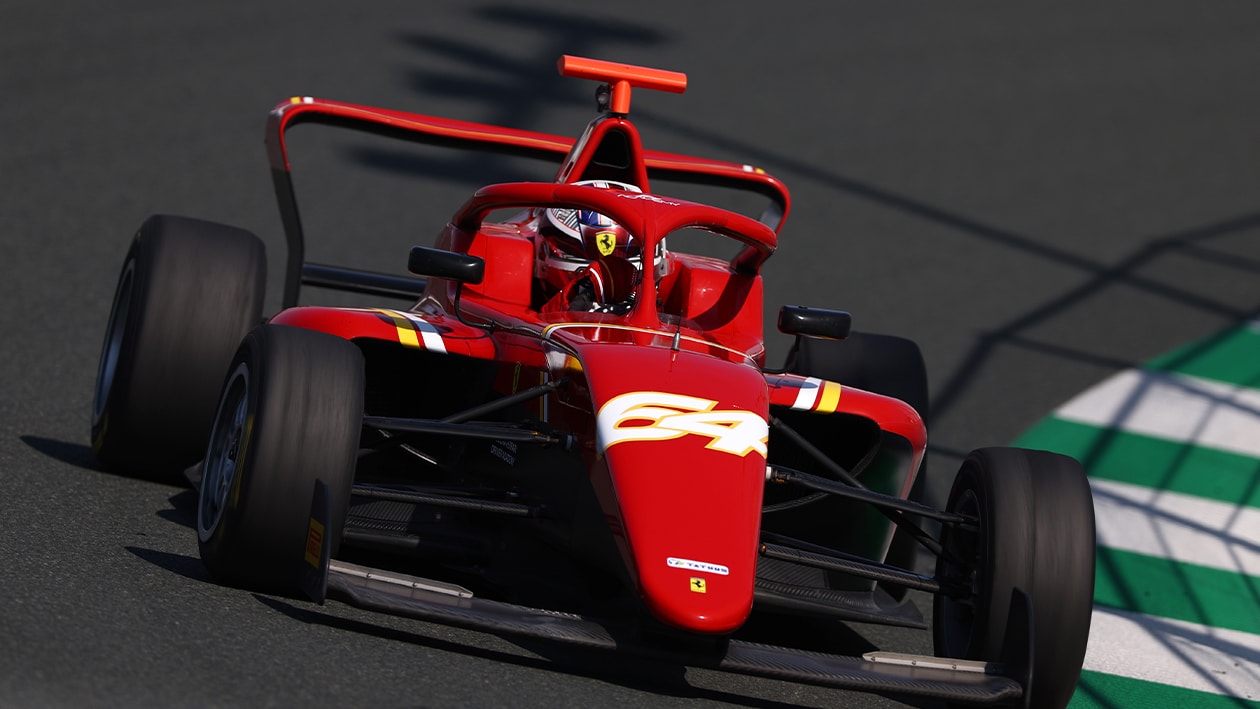
Every F1 constructor has one nominated driver, running that team’s livery
It’s not designed as a fast-track to the top of racing; F1 Academy has been named to signal the ambition to have women competing at the pinnacle of motor sport.
The series took up where W Series left off: the original all-female championship, which was free to enter, fell into administration at the beginning of 2023, as F1 Academy was getting started.
Some W Series drivers and teams migrated to across for the inaugural season, including Marta Garcia who earned seven race wins, seven fastest laps, and five pole positions to be crowned as the first F1 Academy Champion with a 56 point gap to Léna Bühler in second place. After taking the title, the Spaniard moved on to a fully-funded seat in the Formula Regional European Championship by Alpine (FRECA) jointly funded by F1 Academy, Prema, Tatuus, and Pirelli. Graduating alongside Marta Garcia, Léna Bühler also joined FRECA for 2024.
How to watch F1 Academy
Last year, F1 Academy came in for criticism when it emerged that races were not available to watch live. This year, viewers are spoilt for choice, with free-to-view live coverage of qualifying and races on the F1 Academy YouTube channel.
In addition, Sky Sports F1 is showing the majority of sessions live, which can also be viewed via the Sky Go and NOW TV apps.
Who runs F1 Academy?
Susie Wolff became Managing Director of F1 Academy shortly after its conception. The former Williams F1 development driver was the first female driver in 22 years to take part in an F1 grand prix weekend in 2014. After retiring from racing in 2015, she became the Team Principal of Venturi Racing in Formula E in 2018 and its CEO in 2021.
Wolff, the wife of Mercedes F1 boss Toto, will work alongside the general manager of F1 Academy, Bruno Michel. Wolff will be responsible for the development of the female racers, securing funding and pathways for the drivers to progress further into motor sport. Michel will run the general operation of the project using his experience in Formula 2 and Formula 2. Both report to Stefano Domenicali, the President and CEO of Formula 1.
How is F1 supporting the series?
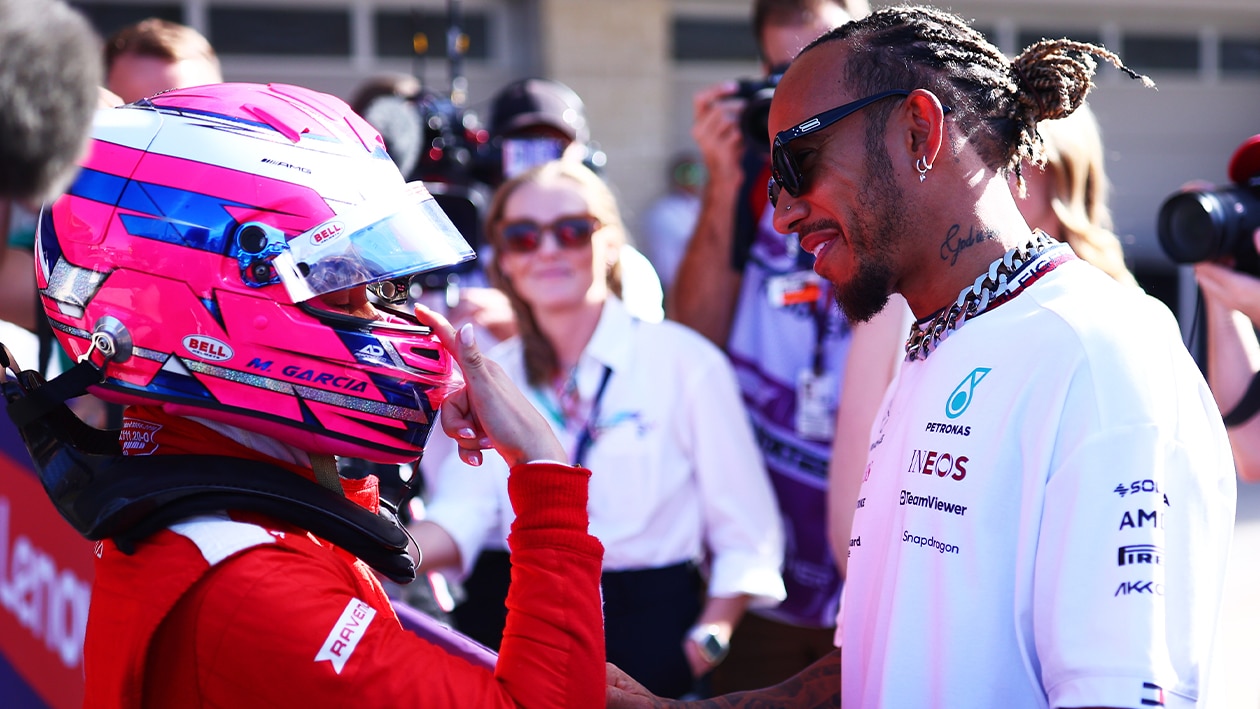
Drivers showed support for F1 Academy last season. This year, there’s more substantial backing
Dan Istitene/F1 via Getty Images
Formula 1 has committed to giving €2.25 million (£1.91 million) in funding to the project to ease the entry cost for drivers and make the sport more accessible. In addition, each team is has nominated one of the drivers on the grid to run a car in their livery. Most have also been integrated into F1 teams’ academy programmes as well.
All drivers are required to make a financial contribution of €150,000 (£85,000) towards the season’s costs, which is cheaper than a typical British F4 season and €50,000 less than last year.
Now featuring on the Formula 1 support bill, each of the seven rounds of the 2024 F1 Academy season will take place on a Formula 1 race weekend, starting in Saudi Arabia.
What car does F1 Academy use?
As a racing series designed to give young drivers the experience needed to progress towards Formula 1, F1 Academy uses a Formula 4-based Tatuus T421 carbon-fibre chassis, powered by a 1.4-litre Autotecnic turbocharged engine, producing 176bhp for a 0-62mph acceleration time of 3.6 sec and a top speed of 150mph.
It features the latest safety measures required by the FIA, including a halo, wheel tethers and anti-intrusion panels, and runs on 13in Pirelli slick tyres.
The cars are run by five teams, which have three entries each. ART Grand Prix, Campos Racing, MP Motorsport, PREMA Racing, and Rodin Motorsport all have additional experience in Formula 3 or Formula 2
What is the F1 Academy race weekend schedule?
The 2024 F1 Academy season will feature seven rounds with two races each. Split over three days, the race weekend begins with either one or two 40-minute practice sessions before heading off to one 30-minute qualifying session. Each driver’s fastest lap time from qualifying will be used to set the grid for Race 1, while their second-fastest lap time will set the order for Race 2.
Both races are 30 minutes each, with schedules and timings released in the lead-up to every round.
How does the F1 Academy points system work?
Points are awarded in F1 Academy for qualifying, so the drivers who take pole position for both races are awarded with two points.
Races follow the same points system as Formula 3, Formula 2, and Formula 1: the top ten classified drivers of each race will score 25, 18, 15, 12, 10, 8, 6, 4, 2, and 1 point respectively. Any driver who achieves the fastest lap time in a race will receive an extra point provided they finish in the points.
| Place | Points |
| 1st | 25 |
| 2nd | 18 |
| 3rd | 15 |
| 4th | 12 |
| 5th | 10 |
| 6th | 8 |
| 7th | 6 |
| 8th | 4 |
| 9th | 2 |
| 10th | 1 |
Super licence points are a new addition to the second season of F1 Academy. The winner of the 2024 season will be awarded 10 points, which compares to 12 offered to the winner of the British F4 championship.
The second-placed driver earns seven, third earns five, fourth earns three, and the fifth placed driver earns one point.
Drivers need a minimum of 40 points to enter Formula 1, but these must have been accumulated in the previous three seasons. With several categories between F1 Academy and Formula 1, it will be a rare driver that reaches F1 fast enough to benefit from an F1 Academy haul. And in any case, have the opportunity to earn enough from F3 and F2, which offer 25 and 40 points respectively to the championship winners. Mercedes academy driver Kimi Antonelli has already earned enough points before his debut F2 season.
2024 F1 Academy calendar
The 2024 season of F1 Academy will start and end in the Middle East, with the first round taking place in Saudi Arabia and the final weekend taking place alongside F1’s season finale in Abu Dhabi.
| Round | Dates | Location |
| Round 1 | 7-9 March | Jeddah, Saudi Arabia |
| Round 2 | 3-5 May | Miami, United States |
| Round 3 | 21-23 June | Barcelona., Spain |
| Round 4 | 23-25 August | Zandvoort, Netherlands |
| Round 5 | 20-22 September | Marina Bay, Singapore |
| Round 6 | 29 November-1 December | Lusail, Qatar |
| Round 7 | 6-8 December | Yas Island, Abu Dhabi |
Who can enter?
The series is open to 15 female drivers between the age of 16 and 25 when entering their first race of the season. Competing drivers are only allowed to compete in two full seasons of F1 Academy, before moving on to make way for more aspiring young female racers. A driver must hold a Grade B, C or D International FIA Licence to compete in a full season.
Who is on the 2024 grid?
With 15 seats on the grid, 11 of which are nominated by Formula 1 teams, the five teams are divided into three seats each. The grid reflects the programme’s goals to create a global series, with drivers on the grid representing eight different nations. While some drivers are set to make an F1 Academy debut, others will be returning for their second and final season of the series.
F1 Academy drivers to watch
There are some standout talents on the grid this season, with Formula 1 teams backing some of the quickest drivers and companies in the fashion industry also supporting competitors.
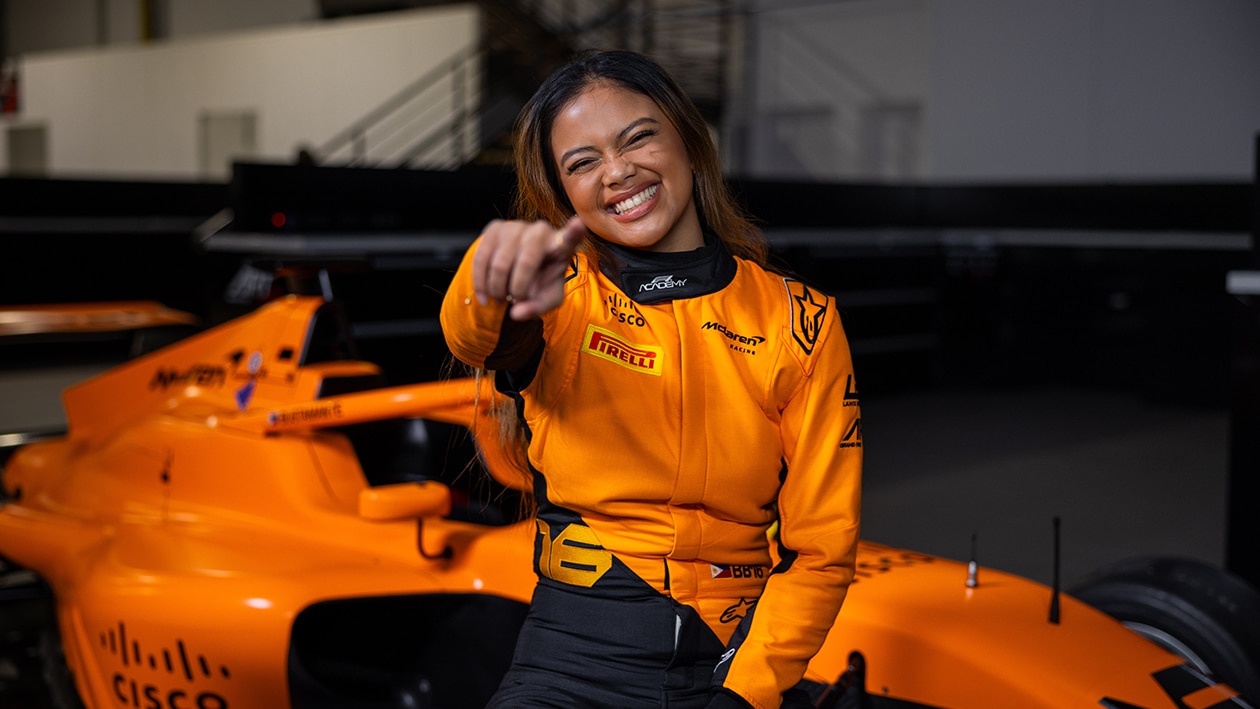
After two race wins in 2023, Bianca Bustamante is in the title hunt
McLaren
Bianca Bustamente is the young and fast Filipina racer who recently signed to McLaren as the first female driver in their development programme. She made headlines as the first nominated driver of F1 Academy, and as a promising talent. Her experience karting in Asia saw her win at the China Grand Prix Kart Scholarship four times. Her first season in F1 Academy earned her two victories and four podiums. Switching from Prema to ART for the 2024 season, she’s definitely coming back to fight for the title.
Abbi Pulling will be returning to the 2024 grid as an Alpine junior searching for the title. The young British driver has had four campaigns in the British F4 Championship, finishing sixth as a rookie. With seven podiums, two pole positions, and four fastest laps, Pulling will be on the hunt for her first single-seater title win.
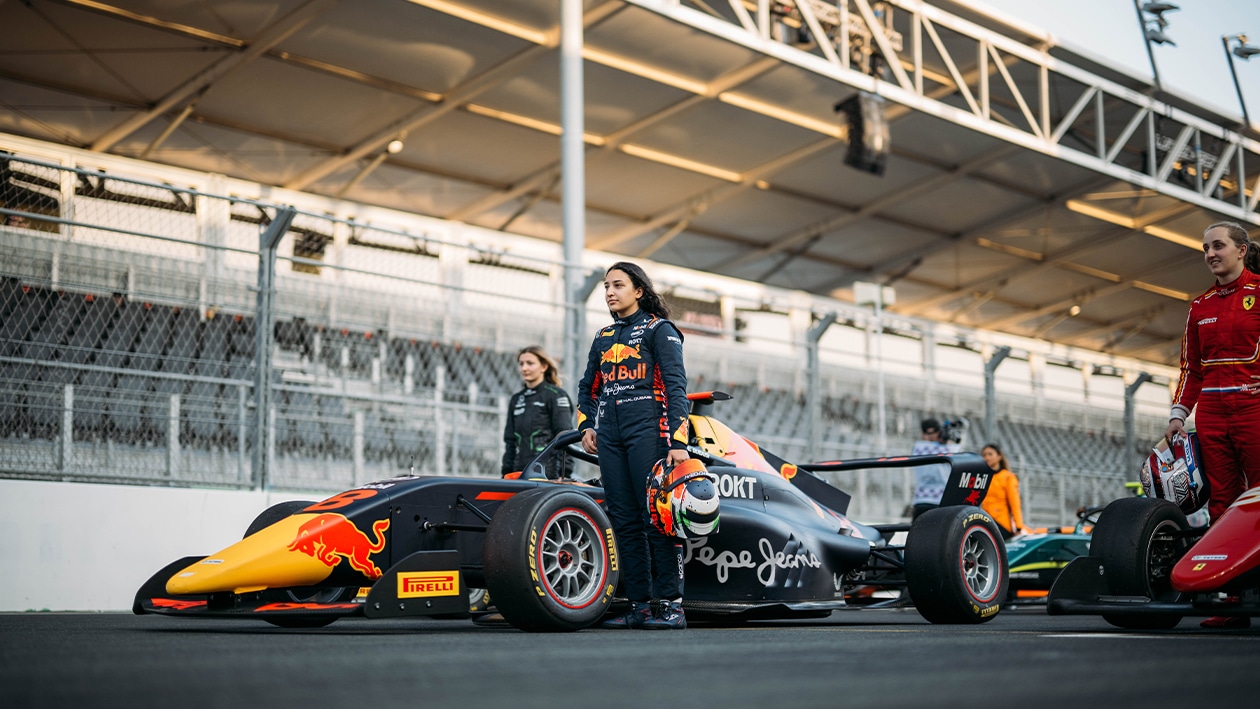
Hamda Al Qubaisi was third last year
Red Bull
Hamda Al Qubaisi is the newly-signed Red Bull Racing Academy Programme driver, returning as the highest-ranked driver on the grid. Stacking up wins in her karting career through to a P4 finish in Formula 4 UAE, she is one of the fastest drivers on the grid. Finishing third in the inaugural season of F1 Academy with four wins to her name, Al Qubaisi will be in contention for the title.
Doriane Pin will make her F1 Academy debut with Prema after being signed to the Mercedes Junior Programme in 2023. Her slot on the 2024 grid will mark her first full run at single-seaters after making the jump from endurance racing. The 20-year-old has five podiums at the Le Mans Cup in 2021, taking victory in her class at the 2022 European Le Mans Series season-finale. If there is any rookie to look out for, it’s the Frenchwoman.

A member of the Mercedes Junior programme, Doriane Pin makes her debut in F1 Academy this year
Pauline Ballet/F1 via Getty Images
F1 Academy: full grid
| Team | Driver | Nationality | Supporter |
| ART Grand Prix | Bianca Bustamante | Filipino | McLaren |
| Aurelia Nobels | Brazilian | Puma | |
| Lia Block | American | Williams | |
| Campos Racing | Chloe Chambers | American | Haas |
| Carrie Schreiner | German | Sauber | |
| Nerea Martí | Spanish | Tommy Hilfiger | |
| MP Motorsport | Emely De Heus | Dutch | Red Bull Ford |
| Hamda Al Qubaisi | Emirati | Red Bull Racing | |
| Amna Al Qubaisi | Emirati | RB | |
| Prema Racing | Tina Hausmann | Swiss | Aston Martin |
| Doriane Pin | French | Mercedes | |
| Maya Weug | Dutch | Ferrari | |
| Rodin Motorsport | Lola Lovinfosse | French | Charlotte Tilbury |
| Abbi Pulling | British | Alpine | |
| Jessica Edgar | British | n/a |
How did the first F1 Academy season go?
The inaugural season featured three races over the course of seven rounds. There were nine different race winners in a grid of 15 drivers, with each driver earning points in their rookie season. Winning the opening race of the season at the Red Bull Ring, Marta Garcia set the tone for the title fight. She won two of the three races in the first round, finishing seventh in the first race. Fighting against Léna Bühler and Hamda Al Qubaisi for the championship, she finished 56 points above Bühler in second, and 61 points above Al Qubaisi in third.
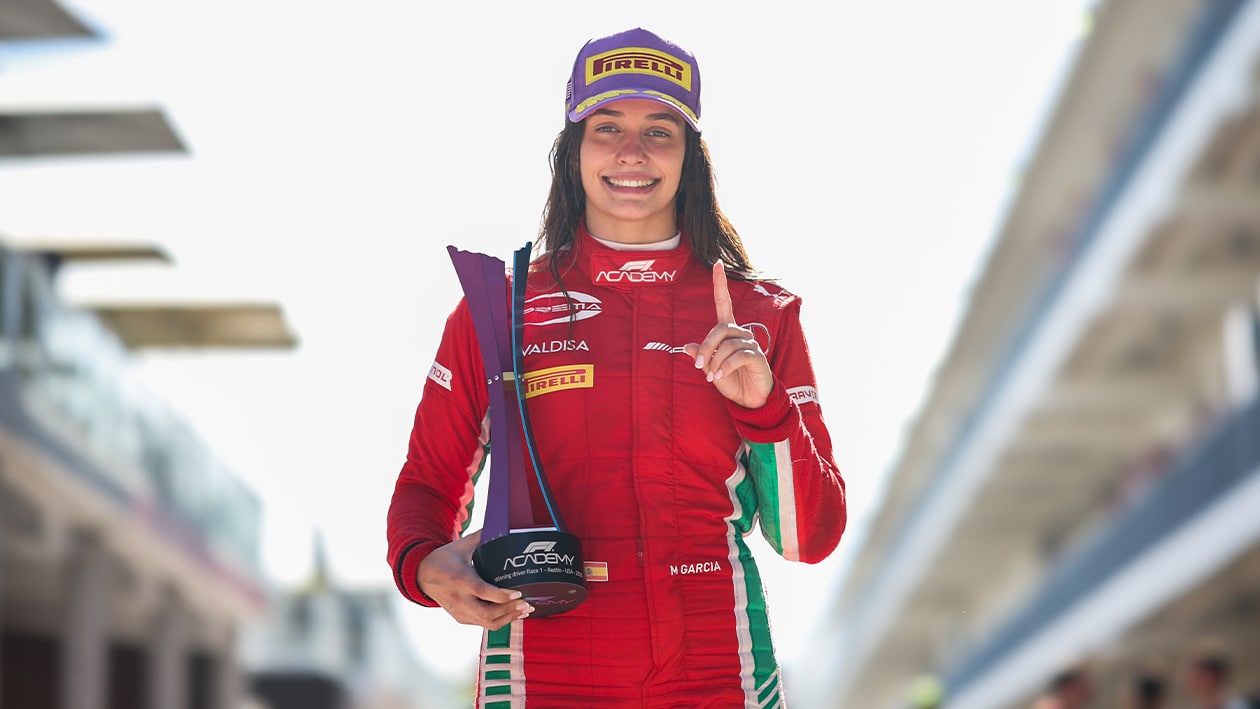
Marta Garcia: victorious in 2023
Jared C. Tilton/F1 via Getty Images
The teams’ championship finished far closer than the drivers’ championship fight. Prema Racing finished the season in first place with 419 points, with MP Motorsport only eight points behind. Rodin Carlin sat in third place with 320 points, almost 100 points off the winner.
However, a reduced audience saw the action, with only highlights and footage released on social media, indicating that the series was being filmed. The live broadcast was not aired.
What is changing for 2024?
- The second season will follow a format closer to Formula 1. Initially, there were three races per round but the race weekend will now feature either one or two free practice sessions, depending on the round, Qualifying, and two races.
- The greatest change to the structure is the greater involvement of Formula 1, with each nominating and sponsoring a driver on the grid.
- Driver contributions have been lowered by €50,000 (£43,000) this year.
- Wild Card entries are also a new development, giving local drivers from each region a chance to show their talent in their home race. The title-defending team PREMA Racing will operate a fourth car for the Wild Card entrant to race in, with the opportunity to score points in the drivers’ standings.
- Super licence points are now awarded to the top five classified drivers in the standings
- There will now be free-to-air live coverage of races
